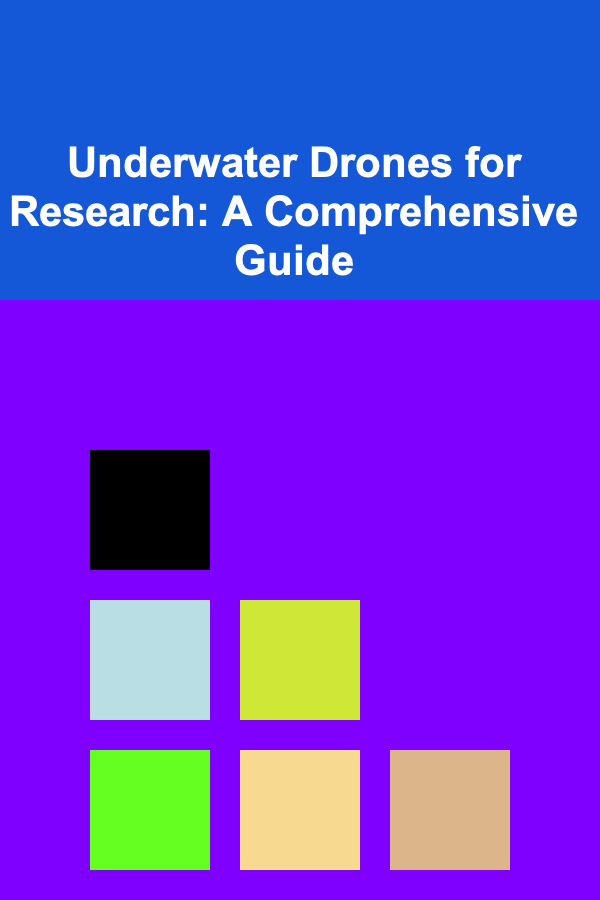
Underwater Drones for Research: A Comprehensive Guide
ebook include PDF & Audio bundle (Micro Guide)
$12.99$11.99
Limited Time Offer! Order within the next:

Underwater drones, also known as remotely operated vehicles (ROVs) and autonomous underwater vehicles (AUVs), have revolutionized marine research. They provide scientists with unprecedented access to the underwater world, allowing for data collection, observation, and experimentation in environments previously inaccessible or too dangerous for human divers. This article explores the diverse applications of underwater drones in research, covering various disciplines, drone types, operational considerations, and the ethical implications of their use.
The Rise of Underwater Drones in Research
For decades, marine research relied heavily on manned submersibles, divers, and ship-based instruments. While these methods remain valuable, they are often limited by depth, duration, cost, and safety concerns. Underwater drones offer a compelling alternative, enabling researchers to explore deeper, survey wider areas, and collect data more efficiently. Their decreasing cost, increasing sophistication, and ease of deployment have fueled their widespread adoption across numerous scientific fields.
The technological advancements driving this trend are significant. Improved battery life allows for longer missions, while enhanced sensor technology provides higher-resolution data. Miniaturization of components has led to smaller, more agile drones, capable of navigating complex underwater environments. Real-time video transmission, advanced navigation systems, and sophisticated data analysis tools further enhance their utility.
Furthermore, the use of artificial intelligence (AI) and machine learning (ML) is transforming underwater drone capabilities. AI-powered image recognition can identify marine species, detect anomalies on the seafloor, and automate data analysis. ML algorithms can optimize navigation routes, predict equipment failures, and even autonomously adapt to changing environmental conditions.
Types of Underwater Drones: ROVs and AUVs
Underwater drones primarily fall into two categories: Remotely Operated Vehicles (ROVs) and Autonomous Underwater Vehicles (AUVs). Understanding their distinct characteristics is crucial for selecting the appropriate drone for a specific research task.
Remotely Operated Vehicles (ROVs)
ROVs are tethered to a surface vessel or control station via an umbilical cable. This cable provides power, transmits control signals, and relays data in real-time. The operator controls the ROV's movements and operates its onboard instruments from the surface.
Advantages of ROVs:
- Real-time Control: Operators have direct and immediate control over the ROV's movements and operations.
- High Power: The tethered power supply allows for the use of powerful instruments and extended mission durations.
- Real-time Data: Data is transmitted to the surface in real-time, enabling immediate analysis and decision-making.
- Payload Capacity: ROVs can typically carry heavier and more complex payloads than AUVs.
Disadvantages of ROVs:
- Limited Range: The umbilical cable restricts the ROV's range and maneuverability.
- Tether Drag: The tether can be affected by currents and create drag, making precise navigation challenging.
- Surface Vessel Dependence: ROV operations require a support vessel, increasing costs and logistical complexity.
- Operational Risks: The tether can become entangled or damaged, posing risks to the ROV and the environment.
Autonomous Underwater Vehicles (AUVs)
AUVs are untethered robots that operate independently, following pre-programmed mission plans. They use onboard sensors and computers to navigate, collect data, and avoid obstacles. AUVs are typically battery-powered and surface periodically to transmit data and receive new instructions.
Advantages of AUVs:
- Extended Range: AUVs can cover vast distances and explore areas inaccessible to ROVs.
- Autonomous Operation: AUVs can operate independently, reducing the need for constant human supervision.
- Reduced Operational Costs: AUV operations require less surface support than ROVs, leading to lower costs.
- Data Consistency: AUVs follow pre-programmed paths, ensuring consistent data collection across large areas.
Disadvantages of AUVs:
- Limited Real-time Control: Operators cannot directly control the AUV during its mission.
- Lower Power: Battery power limits mission duration and instrument capabilities.
- Delayed Data Access: Data is typically only accessible after the AUV surfaces.
- Complex Programming: AUV missions require careful planning and programming, including contingency plans for unexpected events.
Hybrid Systems
Emerging hybrid ROV/AUV systems combine the advantages of both technologies. These systems can operate in tethered mode for precise manipulation and real-time control, and in autonomous mode for extended surveys and data collection. Hybrid drones offer greater flexibility and versatility for a wider range of research applications.
Applications in Marine Research
Underwater drones are transforming marine research across a wide range of disciplines. Their ability to access remote and hazardous environments makes them invaluable tools for scientific discovery and environmental monitoring.
Marine Biology and Ecology
Underwater drones are used to study marine organisms and their habitats in unprecedented detail. They can:
- Conduct visual surveys of coral reefs: ROVs and AUVs equipped with high-resolution cameras can map coral reef ecosystems, assess coral health, and monitor changes over time. They can identify coral bleaching, disease outbreaks, and the impact of human activities.
- Monitor fish populations: Drones can be used to track fish movements, estimate population sizes, and study their behavior. Acoustic sensors can detect fish sounds, while video cameras can record their interactions.
- Explore deep-sea ecosystems: ROVs are essential for exploring the deep sea, where sunlight cannot penetrate. They can collect samples of deep-sea organisms, study hydrothermal vents, and investigate the biodiversity of abyssal plains.
- Track marine mammals: Drones can be used to track the movements of whales, dolphins, and seals, and study their behavior and communication. Acoustic sensors can record their vocalizations, while video cameras can document their feeding habits.
- Assess the impact of pollution: Drones can be used to monitor the spread of pollutants, such as oil spills and plastic debris, and assess their impact on marine ecosystems. Water quality sensors can measure the concentration of pollutants, while video cameras can document the extent of the damage.
Oceanography and Geology
Underwater drones provide valuable insights into oceanographic processes and geological features. They can:
- Map the seafloor: AUVs equipped with sonar systems can create detailed maps of the seafloor, revealing geological features such as seamounts, canyons, and underwater volcanoes. These maps are essential for understanding ocean currents, predicting earthquakes, and managing marine resources.
- Monitor ocean currents: Drones can be used to measure ocean currents, temperature, and salinity, providing valuable data for climate models and ocean forecasting. They can also track the movement of water masses and identify areas of upwelling and downwelling.
- Study hydrothermal vents: ROVs are used to explore hydrothermal vents, which are openings in the seafloor that release hot, chemically-rich fluids. These vents support unique ecosystems of chemosynthetic organisms and are important for understanding the Earth's geochemistry.
- Investigate underwater landslides: Drones can be used to study underwater landslides, which can trigger tsunamis and disrupt seafloor infrastructure. They can map the extent of the landslides, assess their stability, and monitor their potential for future movement.
- Monitor sediment transport: AUVs can track the movement of sediment along the seafloor, providing insights into coastal erosion, sediment deposition, and the formation of sedimentary rocks. They can also measure the concentration of suspended sediment in the water column.
Archaeology
Underwater drones are increasingly used in maritime archaeology to discover and document submerged cultural heritage sites. They can:
- Search for shipwrecks: AUVs equipped with sonar systems can be used to search for shipwrecks and other submerged archaeological sites. They can cover large areas quickly and efficiently, identifying potential targets for further investigation.
- Create 3D models of shipwrecks: ROVs and AUVs can capture high-resolution images of shipwrecks, which can be used to create detailed 3D models. These models allow archaeologists to study the shipwrecks without disturbing them and can be used for virtual tourism.
- Excavate underwater sites: ROVs equipped with specialized tools can be used to excavate underwater archaeological sites. They can carefully remove sediment and artifacts, preserving them for further study.
- Monitor the condition of submerged artifacts: Drones can be used to monitor the condition of submerged artifacts, such as cannons, anchors, and pottery. They can identify signs of deterioration and inform conservation efforts.
- Study submerged landscapes: AUVs can be used to map submerged landscapes, revealing evidence of past human activity, such as settlements and agricultural fields. These landscapes provide valuable insights into the history of human-environment interactions.
Engineering and Infrastructure Inspection
Underwater drones play a critical role in inspecting and maintaining underwater infrastructure, ensuring its safety and reliability. They can:
- Inspect pipelines: ROVs are used to inspect underwater pipelines for corrosion, leaks, and damage. They can identify potential problems early on, preventing costly repairs and environmental damage.
- Inspect bridges and dams: Drones can be used to inspect the underwater foundations of bridges and dams, identifying cracks, erosion, and other structural weaknesses. This information is crucial for ensuring the safety and stability of these structures.
- Inspect offshore oil and gas platforms: ROVs are used to inspect the submerged components of offshore oil and gas platforms, ensuring their structural integrity and preventing leaks. They can also be used to perform maintenance tasks, such as cleaning and repairs.
- Inspect subsea cables: Drones can be used to inspect subsea cables, which transmit telecommunications signals and electricity across the ocean floor. They can identify damage caused by fishing gear, anchors, and natural disasters.
- Monitor underwater construction projects: Drones can be used to monitor underwater construction projects, such as the installation of wind turbines and the construction of tunnels. They can ensure that the projects are being completed safely and according to specifications.
Operational Considerations
Operating underwater drones for research requires careful planning, execution, and adherence to safety protocols. Several factors must be considered to ensure successful and responsible operations.
Drone Selection
The choice between an ROV and an AUV depends on the specific research objectives, the environment, and the available resources. Consider:
- Mission objectives: What type of data needs to be collected? Does the mission require real-time control or autonomous operation?
- Environment: What is the depth, current, and visibility of the environment? Are there any obstacles or hazards?
- Budget: What is the available budget for drone acquisition, maintenance, and operation?
- Expertise: Does the research team have the necessary expertise to operate and maintain the drone?
Sensor Selection and Calibration
The selection of appropriate sensors is crucial for collecting accurate and relevant data. Common sensors include:
- Cameras: For visual surveys and documentation. Consider resolution, frame rate, and low-light performance.
- Sonar: For mapping the seafloor and detecting objects. Consider frequency, range, and resolution.
- Water quality sensors: For measuring temperature, salinity, dissolved oxygen, and other parameters. Consider accuracy, precision, and response time.
- Acoustic sensors: For detecting and recording underwater sounds. Consider frequency range, sensitivity, and directional capabilities.
- Current meters: For measuring ocean currents. Consider accuracy, range, and deployment method.
All sensors must be properly calibrated to ensure accurate data. Calibration procedures should be documented and followed rigorously.
Navigation and Positioning
Accurate navigation and positioning are essential for collecting spatially referenced data. Common navigation systems include:
- GPS (Global Positioning System): For surface positioning. GPS signals do not penetrate water, so alternative methods are needed underwater.
- INS (Inertial Navigation System): Uses accelerometers and gyroscopes to estimate position and orientation. Accuracy degrades over time, so INS is often used in conjunction with other navigation systems.
- DVL (Doppler Velocity Log): Measures the velocity of the drone relative to the seafloor. DVL data can be used to improve the accuracy of INS and other navigation systems.
- USBL (Ultra-Short Baseline) and LBL (Long Baseline): Acoustic positioning systems that use transducers on the surface and underwater to determine the drone's position.
Data Management
Efficient data management is crucial for processing, analyzing, and archiving the data collected by underwater drones. Data management protocols should include:
- Data storage: Data should be stored in a secure and accessible location.
- Data backup: Data should be backed up regularly to prevent data loss.
- Data documentation: Data should be well-documented, including metadata about the data collection process, sensor calibration, and data processing methods.
- Data sharing: Data should be shared with other researchers and stakeholders in a responsible and ethical manner.
Safety Protocols
Safety should be the top priority in all underwater drone operations. Safety protocols should include:
- Pre-dive checks: Thoroughly inspect the drone and all its components before each dive.
- Emergency procedures: Develop and practice emergency procedures for various scenarios, such as tether entanglement, equipment failure, and loss of communication.
- Communication: Maintain clear communication between the drone operator, the surface support team, and any other relevant parties.
- Weather monitoring: Monitor weather conditions and sea state before and during operations.
- Risk assessment: Conduct a thorough risk assessment before each operation and take steps to mitigate potential hazards.
Ethical Considerations
The increasing use of underwater drones raises several ethical considerations that researchers must address.
Environmental Impact
Underwater drone operations can have potential environmental impacts, such as:
- Disturbance of marine life: Drones can disturb marine animals through noise, light, and physical contact. Researchers should minimize disturbance by using quiet drones, avoiding sensitive habitats, and maintaining a safe distance from marine animals.
- Damage to fragile ecosystems: Drones can damage fragile ecosystems, such as coral reefs and seagrass beds, through collisions and propeller wash. Researchers should carefully plan their routes and avoid operating drones in sensitive areas.
- Introduction of invasive species: Drones can transport invasive species from one location to another. Researchers should clean their drones thoroughly after each dive to prevent the spread of invasive species.
- Pollution: Drones can leak oil or other fluids, polluting the marine environment. Researchers should regularly inspect their drones for leaks and use environmentally friendly fluids.
Data Privacy
Underwater drones can collect sensitive data about marine environments and human activities. Researchers should protect the privacy of this data by:
- Obtaining informed consent: Obtain informed consent from individuals or communities that may be affected by data collection.
- Anonymizing data: Anonymize data whenever possible to protect the identity of individuals.
- Storing data securely: Store data in a secure location to prevent unauthorized access.
- Sharing data responsibly: Share data with other researchers and stakeholders in a responsible and ethical manner.
Responsible Innovation
As underwater drone technology continues to advance, researchers have a responsibility to ensure that it is used in a responsible and ethical manner. This includes:
- Developing ethical guidelines: Develop ethical guidelines for the use of underwater drones in research.
- Promoting public awareness: Promote public awareness of the benefits and risks of underwater drone technology.
- Engaging with stakeholders: Engage with stakeholders, such as fishermen, conservationists, and policymakers, to address their concerns about underwater drone technology.
- Supporting responsible research: Support research that promotes the responsible and ethical use of underwater drones.
The Future of Underwater Drone Research
The future of underwater drone research is bright, with ongoing advancements in technology and increasing adoption across various disciplines. Here are some key trends and future directions:
- Enhanced Autonomy: Increased autonomy through AI and ML will enable drones to perform more complex tasks without human intervention, such as adaptive sampling, autonomous navigation in challenging environments, and real-time decision-making.
- Improved Sensors: Development of smaller, more sensitive, and more energy-efficient sensors will expand the range of data that can be collected by underwater drones. Hyperspectral imaging, advanced acoustic sensors, and microfluidic sensors are examples of promising technologies.
- Swarm Robotics: The use of multiple drones working together as a swarm will enable researchers to cover larger areas, collect more data, and perform more complex tasks. Swarm robotics will require sophisticated communication and coordination algorithms.
- Wireless Communication: Development of reliable wireless communication technologies will reduce the reliance on tethered ROVs and enable AUVs to communicate with each other and with surface stations in real-time. Acoustic communication and optical communication are potential solutions.
- Integration with other Technologies: Integration of underwater drones with other technologies, such as satellite imagery, remote sensing, and data analytics platforms, will provide a more comprehensive understanding of marine environments.
- Increased Accessibility: Lowering the cost and increasing the ease of use of underwater drones will make them accessible to a wider range of researchers and organizations. This will democratize access to the underwater world and accelerate scientific discovery.
In conclusion, underwater drones are powerful tools that are transforming marine research. By understanding the different types of drones, their applications, operational considerations, and ethical implications, researchers can effectively leverage these technologies to advance our knowledge of the underwater world and address pressing environmental challenges. As technology continues to evolve, underwater drones will play an increasingly important role in scientific discovery, environmental monitoring, and the sustainable management of marine resources.

How to Clean Your Upholstery and Keep It Looking New
Read More
How to Increase Your Home's Value with a Renovation
Read More
Moral Psychology: Understanding the Nature and Function of Moral Reasoning
Read More
How To Secure Your Data on Encrypted Drives
Read More
Understanding the Biology of Sharks: A Deep Dive
Read More
How to Manage Student Loans: A Comprehensive Guide
Read MoreOther Products

How to Clean Your Upholstery and Keep It Looking New
Read More
How to Increase Your Home's Value with a Renovation
Read More
Moral Psychology: Understanding the Nature and Function of Moral Reasoning
Read More
How To Secure Your Data on Encrypted Drives
Read More
Understanding the Biology of Sharks: A Deep Dive
Read More